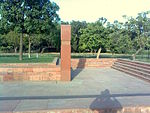Raj Ghat and associated memorials
| Raj Ghat | |
|---|---|
| Coordinates | 28°38′25.8″N 77°14′57.6″E / 28.640500°N 77.249333°E |
| Groundbreaking | 1948 |
Raj Ghat is a
Etymology
Raj Ghat loosely translates to Royal Steps with the word "royal" alluding to the importance of the place and "steps" referencing the climb from the banks of the Yamuna river.[1]
Location
Raj Ghat was the name of a location of historic
List of memorials
The first memorial was dedicated to Mahatma Gandhi on the spot where his remains were cremated on 31 January 1948. It consists of a black marble platform with an eternal flame at one end. A stone footpath leads to the walled enclosure that houses the memorial. Later the memorial complex was expanded to include several other samadhis for various leaders in the vicinity of Raj Ghat. The landscaping and planting of these memorials were originally performed by Alick Percy-Lancaster, Superintendent of Horticultural operations with the Government of India.[3][4][5][6]
In 2000, the Government of India under Vajpayee took a decision to not create separate memorials for different leaders as the already existing memorials were occupying more than 245 acres of prime land in Delhi.[7]
| Name | Title/Position | Date of death | Memorial name (Meaning in English) |
Image |
|---|---|---|---|---|
| Mahatma Gandhi | Leader of Indian Independence movement and Father of the Nation
|
30 January 1948 | Raj Ghat (Royal Platform) |

|
| Jawaharlal Nehru | First Prime Minister of India | 27 May 1964 | Shanti Van (Forest of Peace) |

|
| Lal Bahadur Shastri | Second Prime Minister of India | 11 January 1966 | Vijay Ghat (Victory Platform) |

|
| Sanjay Gandhi | Grandson of Jawaharlal Nehru and former Member of Parliament | 23 June 1980 | Samadhi of Sanjay Gandhi (Tomb of Sanjay Gandhi) |

|
| Indira Gandhi | Third Prime Minister of India | 31 October 1984 | Shakti Sthal (Place of Strength) |

|
| Jagjivan Ram | Fourth Deputy Prime Minister of India | 6 July 1986 | Samta Sthal (Place of Equality) |

|
| Charan Singh | Fifth Prime Minister of India | 29 May 1987 | Kisan Ghat (Farmer Platform) |

|
| Rajiv Gandhi | Sixth Prime Minister of India | 21 May 1991 | Vir Bhumi (Land of Brave) |

|
| Lalita Shastri | Spouse of Lal Bahadur Shastri | 13 April 1993 | Samadhi of Lalita Shastri (Tomb of Lalita Shastri) |

|
Giani Zail Singh
|
Seventh President of India | 25 December 1994 | Ekta Sthal (Place of Unity) |

|
Shanker Dayal Sharma
|
Ninth President of India | 26 December 1999 | Karma Bhumi (Land of Duty) |

|
| Devi Lal | Sixth Deputy Prime Minister of India | 6 April 2001 | Sangharsh Sthal (Place of Struggle) |

|
| P. V. Narasimha Rao | Ninth Prime Minister of India | 23 December 2004 | Smriti Sthal (Place of Remembrance) |

|
| K. R. Narayanan | Tenth President of India | 9 November 2005 | Uday Bhumi (Land of Dawn) |

|
| Chandra Shekhar | Eighth Prime Minister of India | 8 July 2007 | Jannayak Sthal (Place of People's Leader) |

|
R. Venkataraman
|
Eighth President of India | 27 January 2009 | Ekta Sthal (Place of Unity) |

|
| Inder Kumar Gujral | Twelfth Prime Minister of India | 30 November 2012 | Smriti Sthal (Place of Remembrance) |

|
| Atal Bihari Vajpayee | Tenth Prime Minister of India | 16 August 2018 | Sadaiv Atal (Firm Forever) |

|
Controversies
The hard materials used in the memorial had raised a few questions about the nature of Gandhian architecture where there is a stark difference between the architecture of Rajghat and a Gandhian low-cost housing architecture.[8]
References
- ^ Maddipati, Venugopal (January 2017). "When Landscape Became King: A Short Note on the Ascendancy of the Immediate Present as the Sovereign of Rajghat". LA Journal of Landscape Architecture, India. Retrieved 27 January 2020.
- ISBN 81-206-1318-X.
- ^ "No space for 'samadhis', VVIPs to share memorial place in Delhi". Rediff.com. 16 May 2013. Retrieved 30 November 2013.
- ^ "'Rajiv' to bloom at Veer Bhumi". The Tribune Trust. 18 August 2004. Retrieved 21 December 2008.
- The Tribune. The Tribune Trust. 28 December 1999. Retrieved 21 December 2008.
- ^ "Former PM Chandrashekhar's samadhi to be called Jannayak Sthal". The Times of India. 23 April 2015. Retrieved 19 November 2015.
- ^ "History, significance of Rashtriya Smriti Sthal where Atal Bihari Vajpayee's last rites will be held". Financial Express. 17 August 2017. Retrieved 8 August 2023.
- S2CID 225597933. Retrieved 22 August 2020.
- ^ "Narasimha Rao passes away at the age of 83". The Hindu. 24 December 2004. Archived from the original on 30 December 2004. Retrieved 10 July 2012.
- ^ "10 years after death, Narasimha Rao gets memorial in Delhi". The Times of India. 30 June 2015.
